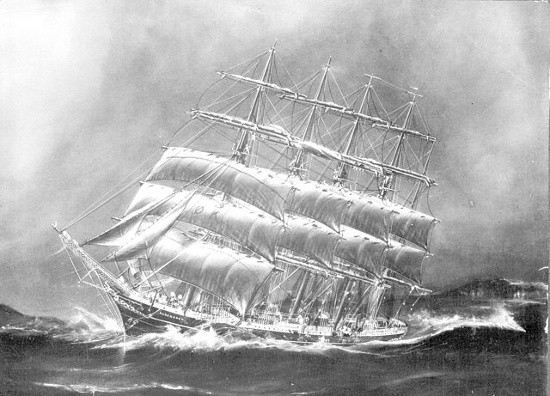The mystery of the world's largest sailing ship
The 130m long Kobenhavn, the tall mast near the mysterious 20-storey building in 1928 while on its journey to Australia. This is the world's largest sailing ship of the time, and so far the ship has not been found.
The last time people heard about Kobenhavn was December 21, 1928 when it was on the way from Buenos Aires (Argentina) to Australia. Immediately after discovering its disappearance, people searched for quite a long time but did not bring results. This has become one of the greatest mysteries of the modern era, leading to speculation about the final fate of the ship.
Kobenhavn was built in Scotland in 1913 but it was not completed until 24 March 1921. Also known as ' Dane Big ', the largest sailing ship in the world at that time was 130m long, accommodating up to 4,000 tons, 5 masts high near the 20-storey building. Kobenhavn has an auxiliary diesel engine, which works like a wireless transmitter.
Mainly used to train young students but the ship also had to find a way to compensate somewhat of the cost by transporting goods during its journeys. Baron Nils Juel-Brockdorff was the supervisor of the shipbuilding and became the first captain. From 1921 to 1928, Kobenhavn successfully carried out nine trips, reaching almost all continents and completing two round-the-world voyages across the sea.

Kobenhavn ships fight against the waves.(Pictures: Wikipedia)
On September 21, 1928, Kobenhavn anchored from Norresundby, North Jutland (northern Denmark). There are 75 people on board, of which the captain is Hans Anderson, 26 crew members and 45 students. Goods that Kobenhavn brought with chalk and cement, are expected to dock in Buenos Aires, take more goods and then go to Melbourne (Australia) and eventually ship wheat to Europe.
Kobenhavn arrived in Buenos Aires on November 17, 1928, impressing the locals by its size. Cargo was immediately unloaded, but the departure was delayed because they did not receive commissions shipped to Australia. Finally, on December 14, Captain Anderson ordered all to leave without cargo. The trip is expected to last 45 days.
On December 22, Kobenhavn kept in touch with a Norwegian ship, William Blumer, 900km from Tristan da Cunha and announced that 'all is well'. However, since then, William Blumer has completely lost Kobenhavn's signal and the crew has not yet appeared again.
Because the journey to Australia lasted for many days plus that Anderson often rarely sent signals during his travels, no one was worried at first when Kobenhavn disappeared until the situation lasted for much. month. In April 1929, East Asiatic Company dispatched a motor-driven ship, Mexico, to the area of Tristan da Cunha.
People said they saw a very large ship with 5 masts, one of which was broken on January 21, 1929. Combined with the Royal Navy, they searched for Kobenhavn for several months but did not have any clues. Finally, the Danish Government had to make a general statement that Kobenhavn and all sailors were missing at sea.
In later years, many theories were made, of which the most accepted was the idea that the ship had hit an iceberg in the dark or fog. If so, the ship may have sunk too quickly, making the crew unable to react. Another group said the lack of cargo on the ship could cause it to be overturned by high winds, neutralizing the lifeboat. However, the body of the ship could not be found.

Kobenhavn train looks sideways.
Two years since Kobenhavn went missing, some people saw the mysterious ship in line with the descriptions of Kobenhavn floating in the Pacific Ocean, sparking debate. According to the Chilean fishermen group, in July 1930, the crew of the Argentinian cargo ship saw the 5-mast "ghost ship" in a strong wind. After a few weeks, they met it again when traveling from Easter Island to the coast of Peru. On the way, they picked up a piece of the body after the engraved ship named 'Kobenhavn'.
Evidence of the ship continued to be aroused in 1934, when The New York Times reported a diary of a practitioner on board Kobenhavn found in a bottle on Bouvet Island in the South Atlantic Ocean. The diary said the ship was destroyed by icebergs and abandoned, all leaving the lifeboat.
In 1935, a number of human remains and the remains of a lifeboat found buried in sand along the southwestern coast of Africa are believed to be traces of Kobenhavn. However, until now, all are still at the presumptive level, waiting for answers from experts.
- Saving money, Airbus company developed kites for sailing ships
- Drive the ship on Saturn's surface
- Video: World's largest super yacht of Russian billionaire
- The largest ship explosion in history, killing 2000 people, leveling seaports
- Ghost ship Mary Celeste and mystery for over 100 years
- Discovering many cosmic mysteries, people yearn to find new worlds
- The most mysterious shipwreck in maritime history
- The mystery of the 'ghost' mahogany ship at sea
- China shipped the world's largest container ship
- Explore the world's largest shipyard
- The mystery of cruise ships suddenly disappeared at sea
- Answer the mystery about the ship at the foot of the New York Twin Towers
 The truth about the mysterious red-haired giant at Lovelock Cave
The truth about the mysterious red-haired giant at Lovelock Cave Inunaki Tunnel: The haunted road leading into Japan's 'village of death'
Inunaki Tunnel: The haunted road leading into Japan's 'village of death' The mystery of the phenomenon of human reflection before dying
The mystery of the phenomenon of human reflection before dying 6 mysterious phenomena, although science has been developed for a long time, still cannot be answered
6 mysterious phenomena, although science has been developed for a long time, still cannot be answered